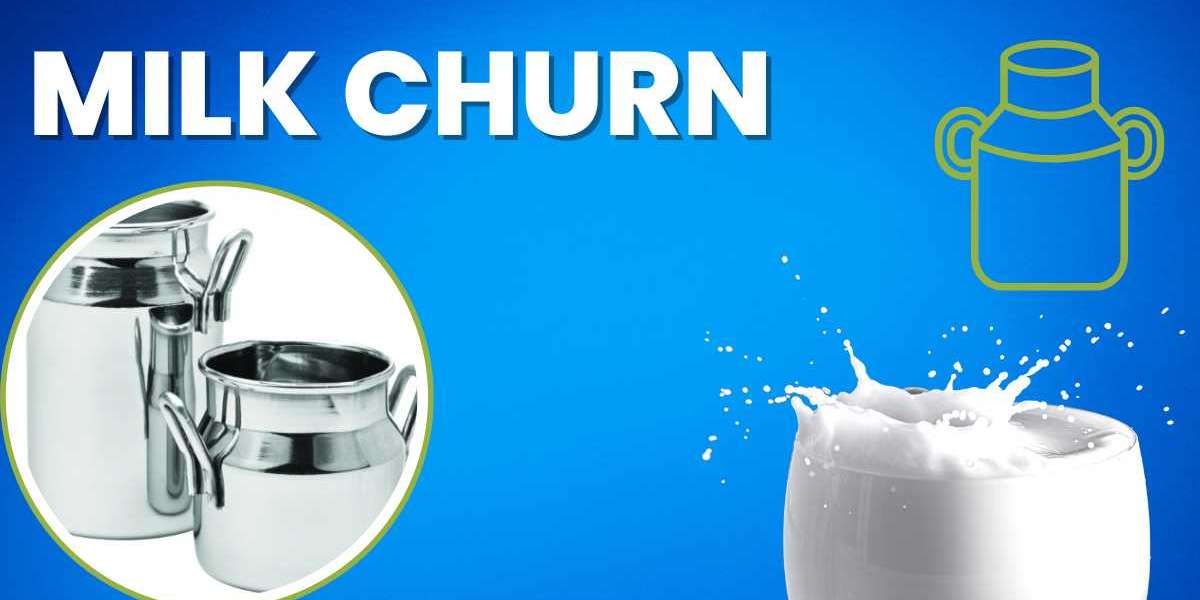Milk churns are often overlooked in today’s fast-paced world of dairy production, but they play a critical role in the storage and transportation of fresh milk. Traditionally, these containers were a staple of dairy farms worldwide, ensuring that milk was preserved in optimal condition from farm to dairy. Even with modern advancements in dairy equipment, the humble milk churn continues to hold significance for both small-scale farmers and milk enthusiasts alike. Let’s delve into the history, design, and continued relevance of the milk churn in today’s dairy industry.
What is a Milk Churn?
A milk churn is a large, cylindrical container, typically made from stainless steel or aluminum, used to store and transport fresh milk. Before the advent of modern refrigerated trucks and bulk tanks, milk churns were the primary means of transporting milk from farms to processing plants. Their design allowed for easy handling and provided an insulated environment that helped to preserve milk during transit.
Historically, milk churns were made of wood or metal and would hold between 10 and 12 gallons of milk. Today, while smaller than some modern equipment, their use is still widespread in rural or small-scale dairy operations.
The Evolution of Milk Churns in Dairy Farming
Milk churns have a fascinating history that dates back centuries. Originally made from wood, these churns evolved into galvanized steel or aluminum containers, providing improved durability and hygiene. The transition to metal containers also improved the freshness of the milk, as it kept it cooler for longer periods.
In the early 20th century, the use of milk churns was common across Europe and North America. They were an essential part of dairy logistics, as milk had to be transported from farms to towns and cities without refrigeration. These churns were often loaded onto carts or railway wagons, traveling miles to reach their destinations.
Though large tankers have now largely replaced them in industrialized dairy operations, milk churns are still used in many rural communities, where the scale of production doesn’t warrant the use of massive bulk tanks.
Why Milk Churns Still Matter Today
While technological advancements have introduced bulk milk tanks and automated systems in larger dairies, milk churns are still highly relevant today for several reasons:
Cost-Effective: Milk churns are much more affordable for small dairy farmers compared to the cost of bulk tanks or refrigerated trucks.
Portability: Their size makes them easier to move around, making them practical for transporting milk across short distances, especially in rural areas.
Durability: High-quality milk churns made from stainless steel or aluminum last for years, making them a sustainable investment for small dairy farms.
Tradition: Many smaller dairy operations pride themselves on traditional methods of milk production, and using a milk churn is part of this heritage.
The Modern Use of Milk Churns
Despite the technological innovations in the dairy industry, milk churns have maintained their relevance. They are especially useful in regions where farms are smaller, and the infrastructure for large-scale milk transportation is lacking. In these areas, farmers often rely on milk churns to deliver their fresh milk to local cooperatives or dairies.
In some cases, milk churns are also used in artisanal cheese production. Small-scale cheese makers often prefer to use traditional methods of handling milk, and the use of milk churns can be seen as a hallmark of quality.
Milk churns are also used for purposes beyond dairy farming. They have found their way into homes and businesses as decorative pieces. The vintage appeal of these churns has led to their popularity in rustic interior designs, repurposed as anything from planters to furniture.
How Milk Churns Compare to Modern Milk Storage Solutions
Milk churns offer unique advantages compared to modern alternatives, such as bulk tanks. While bulk tanks are more suited for large-scale operations due to their size and refrigeration capabilities, milk churns shine in smaller setups. Here’s how the two compare:
Scale of Use: Bulk tanks can store thousands of liters of milk, whereas churns are designed for smaller volumes, typically between 10 to 20 gallons.
Cost: The affordability of milk churns is a significant benefit. Bulk tanks and refrigeration equipment can be prohibitively expensive for small dairy farms.
Portability: Milk churns are easier to move and transport, making them ideal for farmers who deliver milk directly to customers or local processors.
While both methods have their place in the dairy industry, it’s clear that the milk churn continues to serve a vital role in more localized, small-scale dairy operations.
Key Features of a High-Quality Milk Churn
When choosing a milk churn for dairy farming, there are several important features to consider to ensure the best performance and longevity. High-quality churns should have:
Durable Construction: Look for churns made from stainless steel or high-quality aluminum, as these materials are rust-resistant and can withstand regular use.
Proper Insulation: A good milk churn should offer insulation to help maintain the milk's freshness for as long as possible. This is especially important for longer transport times.
Ease of Cleaning: Hygiene is crucial in dairy farming, so a churn should be designed for easy cleaning, with smooth interior surfaces and detachable parts if possible.
The Role of Milk Churns in Sustainable Dairy Farming
In today’s increasingly eco-conscious world, milk churns provide a sustainable alternative to more energy-intensive milk storage solutions. They don’t require electricity or complex systems to function, which significantly reduces the carbon footprint of small dairy farms.
Additionally, milk churns are long-lasting, reducing the need for frequent replacements. This sustainability factor is particularly important as consumers become more interested in the environmental impact of their food choices.
By using milk churns, dairy farmers can not only lower their costs but also offer consumers a product that aligns with the growing demand for environmentally friendly food production.
How to Properly Maintain a Milk Churn
Maintaining your milk churn is essential to ensure it lasts for many years and continues to perform at its best. Regular cleaning and maintenance are key to preventing contamination and prolonging the churn’s lifespan. Here are some tips for maintaining your milk churn:
Clean After Each Use: Immediately after the milk is transferred, rinse the churn with cold water to remove any remaining milk residue. Follow this with a thorough cleaning using hot water and a dairy-safe detergent.
Inspect for Damage: Regularly check for dents, cracks, or rust, especially if your churn is made from steel. These can compromise the cleanliness and safety of the milk stored in it.
Store Properly: When not in use, store your milk churn in a dry, cool place to prevent rusting and degradation of the material.
FAQs
What is a milk churn used for?
A milk churn is used to store and transport fresh milk from dairy farms to processing plants or local cooperatives. It is especially common in small-scale dairy farming operations.
Why do some farmers still use milk churns instead of bulk tanks?
Some farmers prefer milk churns because they are more affordable, portable, and ideal for small-scale dairy operations. Bulk tanks, while useful for large farms, can be too expensive or impractical for smaller producers.
Are milk churns made from different materials?
Yes, modern milk churns are typically made from stainless steel or aluminum, though older versions were made from wood or galvanized steel. Stainless steel is preferred for its durability and hygiene benefits.
How much milk can a typical milk churn hold?
The capacity of a milk churn varies, but most can hold between 10 to 12 gallons of milk, making them ideal for smaller farms or short-distance transport.
Can milk churns be used for anything besides dairy farming?
Yes, milk churns are often repurposed for decorative use in homes or gardens. Their rustic appeal makes them popular for interior design, and they are sometimes used as planters or furniture.
How should I clean and maintain my milk churn?
To maintain your milk churn, it should be cleaned thoroughly after each use with hot water and dairy-safe detergent. Regular inspection for damage, such as cracks or rust, will also help prolong its life.
Conclusion
The milk churn remains an essential tool in the dairy farming world, particularly for small-scale and traditional dairy operations. It offers a cost-effective, durable, and portable solution for milk storage and transportation. Though modern technology has transformed much of the dairy industry, the humble milk churn continues to serve farmers and artisans alike, symbolizing a blend of tradition and practicality.








